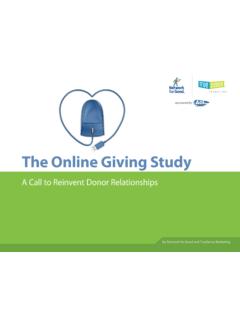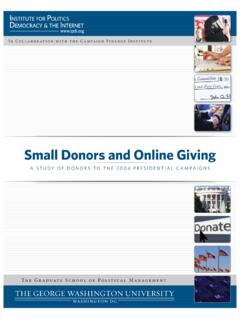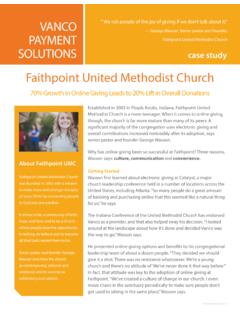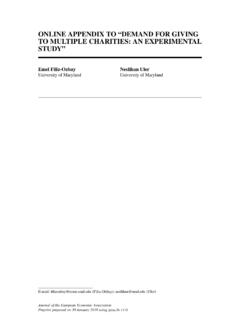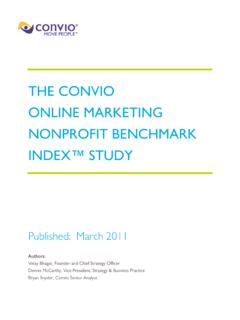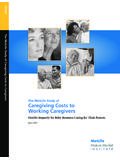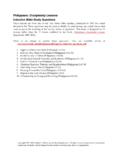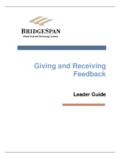Transcription of www.achieveguidance - Case Foundation
1 RESEARCH BY. w w w . a ch i e v e g u i d a n c e . c o m TABLE OF CONTENTS. 3 INTRODUCTION. 4 ABOUT THE RESEARCH. 5 EXECUTIVE SUMMARY. 10 CONNECT. 22 INVOLVE. 27 GIVE. 32 CONCLUSION. 33 BUILD YOUR ORGANIZATION. 2013. INTRODUCTION. THE 2013 millennial impact REPORT. Since 2009, the millennial impact Report has uncovered comprehensive data that reveals this rising generation is eager to connect, get involved, and give to causes they're passionate about. And over that time, we've zeroed in on the millennial behaviors of greatest interest to nonprofits first their trends in giving , then in service, and now in communication. For those new to the millennial impact Report, here are the need-to-know' trends that have emerged in the past few years: MILLENNIALS PREFER TO CONNECT VIA TECHNOLOGY They use websites and search engines primarily for information-gathering, finding volunteer opportunities, and donating online.
2 They rely on social media and email for communicating and connecting with their networks, while mobile technology gives them instant access to all these channels. MILLENNIALS SHARE IN MICRO WAYS Their interactions with nonprofit organizations are likely to be immediate and impulsive. When inspired, they will act quickly in a number of ways, from small donations to short volunteer stints, provided that the opportunities are present and the barriers to entry are low. MILLENNIALS FACILITATE (AND RELY ON) PEER INFLUENCE Peer influence plays an important role in motivating Millennials to volunteer, attend events, participate in programs, and give. Even if Millennials can't give as much as other demographic groups, they nonetheless are willing to help raise funds for causes they care about, usually by calling on friends and family.
3 MILLENNIALS VOLUNTEER ALONG A CONTINUUM OF SUPPORT Millennials are most likely to get hands-on with causes they care about when organizations offer a range of volunteer opportunities, from one-time commitments to long-term, pro-bono skills-based opportunities. Ultimately, they want to lend their knowledge, expertise, and time to help nonprofits. And when this generation forms long-term volunteer relationships, they tend to give larger gifts, as well as encourage their friends and family to contribute, too. MILLENNIALS GIVE TO HAVE AN impact Millennials are consistent in their desire to see how dollars translate into people helped. They want their contributions, no matter the type or amount, to help achieve tangible results for a cause.
4 Yes, members of this generation are more likely to give smaller amounts to multiple organizations than to focus their giving on any one recipient. But the stronger their relationship with an organization, the more likely they are to give larger gifts over time. HOW CAN MY NONPROFIT FULLY INVEST IN THIS GENERATION? Enter the 2013 millennial impact Report, which reveals that Millennials aren't interested in structures, institutions, and organizations, but rather in the people they help and the issues they support. The key for nonprofits, therefore, is to build a comprehensive millennial engagement platform that invites them to participate in the cause and maximize their involvement.
5 As such, this year's report dives deeper into understanding the influence of peer engagement, design, and messaging, and how it all combines to encourage Millennials to act in the moment. What's more, the report introduces a new onboarding system for millennial engagement that will help transform invested Millennials not just into donors, but also into champions, evangelists, and long-term supporters. Regardless of their budget or size, nonprofit organizations have a tremendous opportunity to start thinking holistically about this rising generation. THE millennial impact REPORT 3. ABOUT THE RESEARCH. METHODOLOGY. For the 2013 millennial impact Report, Achieve gathered information from an online survey distributed to Millennials through 14 research partners, as well as conducted usability testing of nine nonprofits' online presence [website, social media pages (Facebook and Twitter), emails, and mobile].
6 For this study , Millennials were defined as anyone born between the years 1979-1994. SURVEY RESPONDENTS. The survey conducted was the fourth consecutive millennial impact survey with responses from 2,665. individuals. Of the respondents, 60% earned an undergraduate degree and 24% earned a master's degree. Most were full-time employees (65%). The survey was open from February 1, 2013 to March 15, 2013. The research included in this report is also supported by the past three years of millennial research, which has surveyed a total of 11,675 people. It is important to note that the report reflects views from a sample population of the millennial generation. RESEARCH PARTNERS. Advocates for Youth ALSAC/St.
7 Jude Children's Research Hospital American Pianists Association AmeriCorps Alums GiveCorps Kiwanis International Foundation /Circle K International Maymount Foundation ONE. One Percent Foundation Pacific Lutheran University Pi Lambda Theta Repair the World Seattle Works The Nature Conservancy USER TESTING OF MILLENNIALS. User testing conducted March 4, 2013 to March 20, 2013. User tests included 100 participants ages 20-35. User tests included video-recorded feedback and usability testing on messaging and online presence [website, social media pages (Facebook and Twitter), emails, and mobile]. RESEARCH TEAM LEAD RESEARCH PARTNER. Derrick Feldmann, CEO. Joanna Nixon, Strategy Consultant Justin Brady, Creative Strategist Lara Brainer-Banker, Senior Designer Lindsay Wheeler, Designer 2013.
8 4. EXECUTIVE SUMMARY. This year, Achieve gathered information from an online survey distributed to Millennials through 14 research partners, and, for the first time, conducted usability testing of nine nonprofits'. online presence that included video feedback. The top takeaway: Millennials first support causes they are passionate about (rather than institutions), so it's up to organizations to inspire them and show them that their support can make a tangible difference on the wider issue. The question for nonprofits becomes then: How can we fully invest in this generation, immerse them in the cause, and maximize the impact of their interest, time, and giving ? CONNECT. Millennials prefer to share information about the Take note: Millennials who want constant cause, not the organization itself.
9 This preference updates on an organization no longer rely on or moves savvy organizations away from traditional return to websites to receive that information. PR and towards content expertise on a cause. Instead, they use websites first to learn about the organization, and then to connect with its Smartphone usage continues to rise, as social networks to stay updated. The smoother mobile devices best enable the connectivity and more integrated the online experience, the and news information gathering from peers, higher the chances for conversion along any mobile content sources, and organizations that point of the engagement pathway. Millennials seek. Some methods for attracting the mobile-friendly millennial audience include: Millennials are highly selective about what organizations they follow in a crowded and noisy a) crafting mobile-friendly email content that media landscape, connecting actively to 1-5.
10 Calls readers to action organizations on social media. Given the rise of supportive activism such as sharing and signing b) posting regularly on Facebook, especially petitions, as well as other forms of micro- with images (the most shared item). volunteering where the norm is not to be on-site c) writing news or action-oriented headlines to with the organization, social media presents an deliver organizational news opportunity to witness the organization's action at work with the people it serves. Organizations should think mobile first and focus on responsive design as well as content, Organizations will know their message is including navigation, context around the resonating when Millennials are compelled to organization's work, and success stories.


